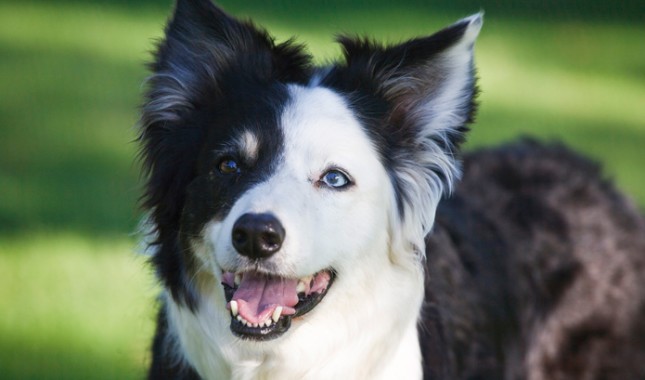The Border Collie (Scottish Sheepdog) is a working and herding dog breed developed in the Scottish borders for herding livestock, especially sheep. It was specifically bred for intelligence and obedience. It is very fetch-oriented.
Considered highly intelligent, extremely energetic, acrobatic and athletic, they frequently compete with great success in sheepdog trials and dog sports. They are often cited as the most intelligent of all domestic dogs. Border collies continue to be employed in their traditional work of herding livestock throughout the world and are kept as pets.
Description
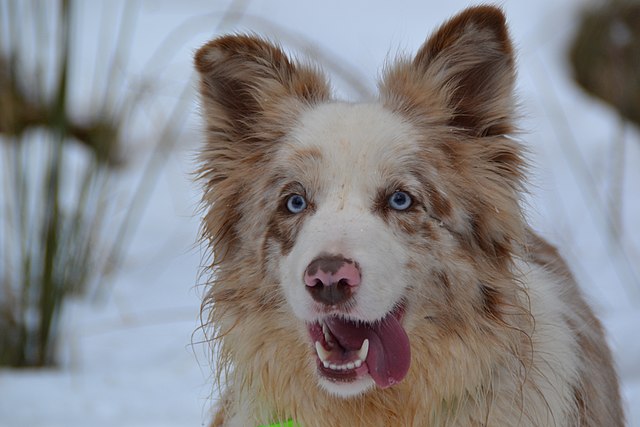
In general, border collies are medium-sized dogs with a moderate amount of coat, which is more often thick and prone to shedding. They have a double coat that varies from smooth to rough and is occasionally curled. While black and white is the most commonly seen colour pattern of the Border Collie, the breed appears in just about any colour and pattern known to occur in dogs. Some of these include black tricolour (black/ tan/ white), liver and white, and red tricolour (red/ tan/ white) which have also been seen regularly, and other colours such as blue, lilac, red merle, blue merle, brindle, and Australian red (also known as ee red, blonde, recessive red, or gold) which is seen less frequently. Some border collies may also have single-colour coats.
Eye colour varies from brown to blue, and occasionally eyes of differing colour occur; this is usually seen with merles. The ears of the border collie are also variable some have fully erect ears, some fully dropped ears, and others semi-erect ears (similar to those of the rough collie). Although working border collie handlers sometimes have superstitions about the appearance of their dogs (handlers may avoid mostly white dogs due to the unfounded idea that sheep will not respect a white or almost all white dog), in general, the American Border Collie Association considers a dog’s appearance to be irrelevant. Instead, it is considered more useful to identify a working border collie by its attitude and ability.
Dogs bred for show are more homogeneous in appearance than working Border collies since to win in conformation showing they must conform closely to breed club standards that are specific on many points of the structure, coat, and colour. Kennel clubs specify, for example, that the border collie must have a “keen and intelligent” expression, and that the preferred eye colour is dark brown. In deference to the dog’s working origin, scars and broken teeth received in the line of duty are not to be counted against a border collie in the show ring. The males’ height from withers comes from 48 to 56 centimetres (19 to 22 in), females from 46 to 53 centimetres (18 to 21 in).
Temperament
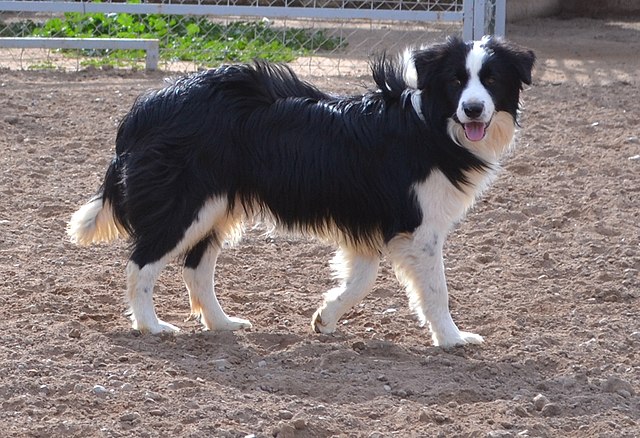
Border collies require considerably more daily physical exercise and mental stimulation than many other breeds. The border collie is widely considered to be the most intelligent dog breed. The border collie ranks 1st in Stanley Coren’s The Intelligence of Dogs, being part of the top 10 brightest dogs. Although the primary role of the border collie is to herd livestock, the breed is becoming increasingly popular as a companion animal.
In this role, due to their working heritage, border collies are very demanding, playful, and energetic. They thrive best in households that can provide them with plenty of play and exercise, either with humans or other dogs. Due to their demanding personalities and need for mental stimulation and exercise, many border collies develop problematic behaviours in households that are not able to provide for their needs. They are infamous for chewing holes in walls and furniture, and destructive scraping and hole digging, due to boredom. Border collies may exhibit a strong desire to herd, a trait they may show with small children, cats, and other dogs. The breed’s herding trait has been deliberately encouraged, as it was in the dogs from which the border collie was developed, by selective breeding for many generations. However, being eminently trainable, they can live amicably with other pets if given proper socialization training.
The American Border Collie Association recommends that potential owners, before taking on the breed as a household pet, should be sure they can provide regular exercise commensurate with the collie’s high energy and prodigious stamina. A working collie may run many miles a day, using its experience, personality, and intelligence to control challenging livestock. These dogs will become distressed and frustrated if left in isolation, ignored or inactive. Like many working breeds, border collies can be motion-sensitive and may chase moving vehicles and bicycles, but this behaviour can be modified by training. Some of the more difficult behaviours require patience, as they are developmental and may disappear as the dog matures.
History
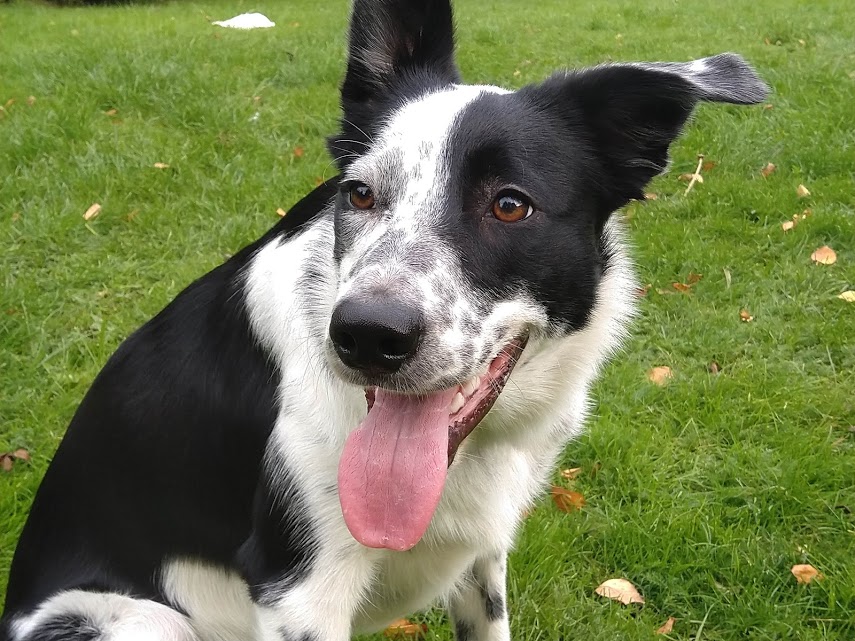
The border collie is descended from landrace collies, a type found widely in the British Isles. The name for the breed came from its probable place of origin along the Anglo-Scottish border. Mention of the “collie” or “Colley” type first appeared toward the end of the 19th century, although the word “collie” is older than this and has its origin in the Scots language. It is also thought that the word ‘collie’ comes from the old Celtic word for useful. Many of the best border collies today can be traced back to a dog known as Old Hemp.
In 1915, James Reid, Secretary of the International Sheep Dog Society (ISDS) in the United Kingdom first used the term “border collie” to distinguish those dogs registered by the ISDS from the Kennel Club’s collie (or Scotch collie, including the rough collie and smooth collie) which originally came from the same working stock but had developed a different, standardised appearance following introduction to the show ring in 1860 and mixture with different breeds.
Livestock work
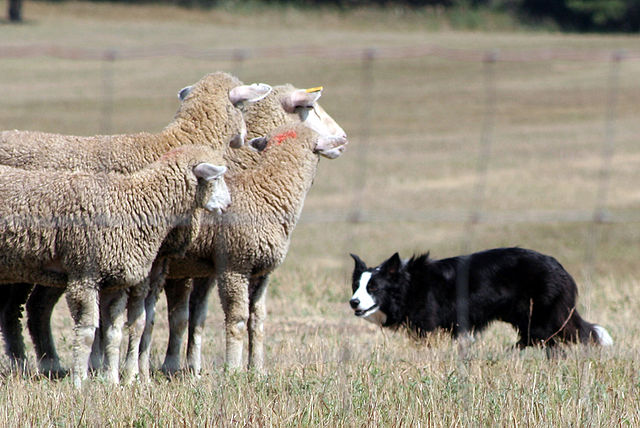
Working border collies can take direction by voice and by whistle at long distances when herding. Their great energy and herding instinct are still used to herd all kinds of animals, from the traditional sheep and cattle to free-range poultry, pigs, and ostriches. They are also used to remove unwanted wild birds from airport runways, golf courses, and other public and private areas.
The use of dogs for herding sheep makes good economic sense for many farmers. In a typical pasture environment, each trained sheepdog will do the work of three humans. In vast arid areas like the Australian Outback or the Karoo Escarpment, the number increases to five or more. Attempts to replace them with mechanical approaches to herding have only achieved a limited amount of success. Thus, stock handlers find trained dogs more reliable and economical.
Shepherds in the UK have taken the most critical elements of herding and incorporated them into a sheepdog trial. The first recorded sheepdog trials were held in Bala, North Wales, in 1873. These competitions enable farmers and shepherds to evaluate possible mates for their working dogs, but they have developed a sport aspect as well, with competitors from outside the farming community also taking part.
In the US, the national sanctioning body for these competitions is the USBCHA. In the UK it is the International Sheep Dog Society, in Canada the Canadian Border Collie Association (CBCA) and in South Africa, it is the South African Sheepdog Association.
Dog sports
Border collies excel at several dog sports in addition to their success in sheepdog trials due to their high instinct of herding. Herding instincts and trainability can be tested for when introduced to sheep or at noncompetitive instinct tests. Border collies exhibiting basic herding instincts can be trained to compete in sheepdog trials and other herding events. They perform well at some higher jump heights at dog agility competitions, so much so that in England, competitions often include classes for ABC dogs, “Anything But Collies”.
The border collie’s speed, agility, and stamina have allowed them to dominate in dog activities like flyball and disc dog competitions. Their trainability has also given them a berth in dog dancing competitions.
Border collies have a highly developed sense of smell and with their high drive make excellent and easily motivated tracking dogs for Tracking trials. These trials simulate the finding of a lost person in a controlled situation where the performance of the dog can be evaluated, with titles awarded for successful dogs.
